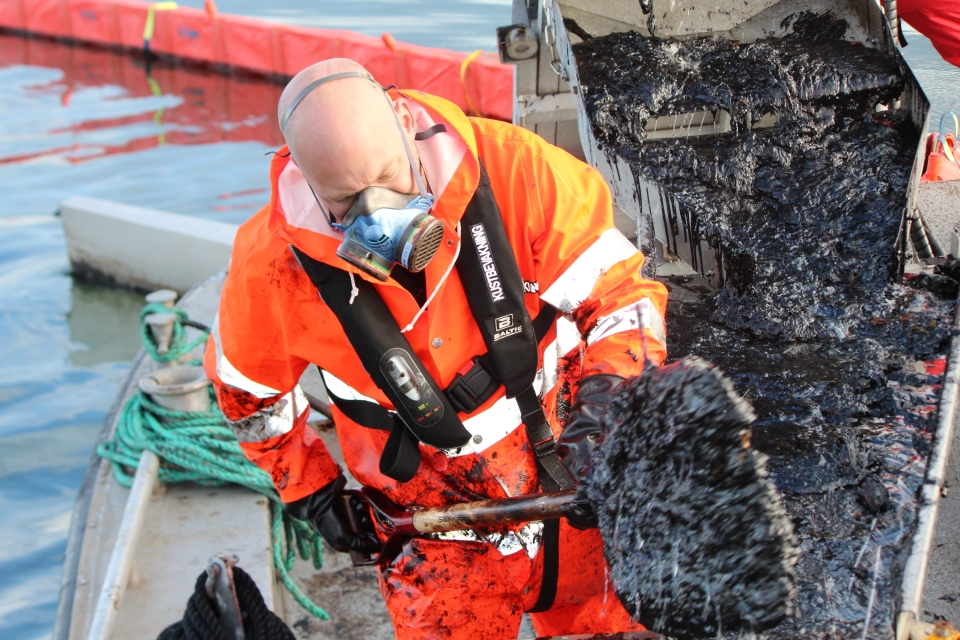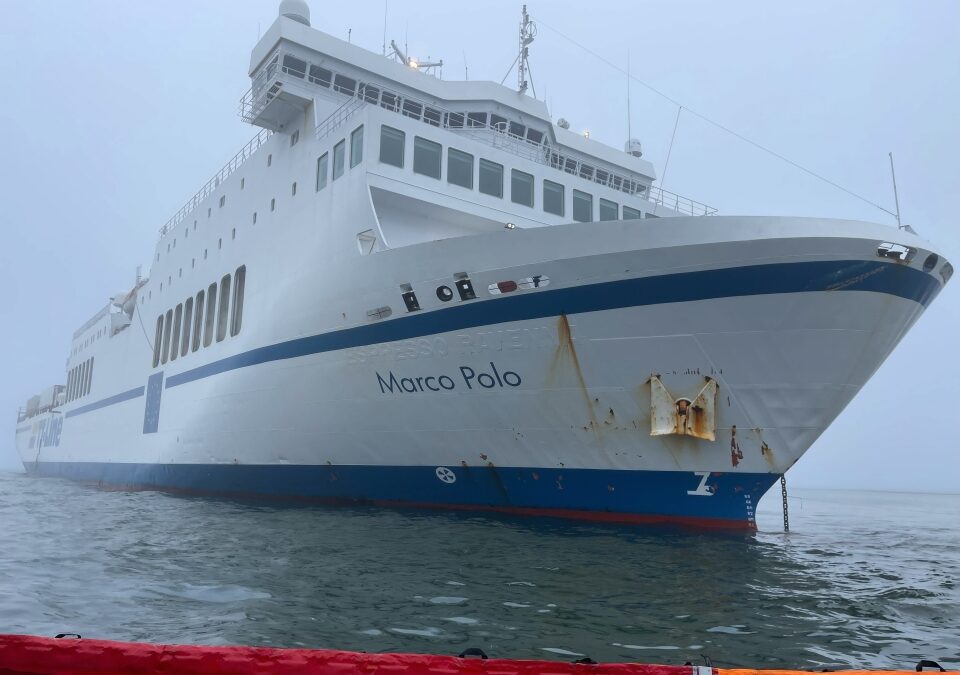At 7 am on Sunday 22 October, TT-line’s passenger ferry Marco Polo ran aground south of Karlshamn, in Pukaviksbukten, Sweden. The 75 passengers and crew were unharmed, but both oil and diesel have leaked into the sea. Smit Salvage has been called in to salvage the ship.
The Sea Rescue Society evacuated the passengers and placed a boom around the ship in cooperation with the Swedish Coast Guard to prevent oil and diesel from spreading in the immediate area. The ship now remains stable on the ground, but there is a risk that the vessel’s stability may be affected by the increasing wind.
‘It has turned out that the ferry ran aground earlier in the morning and leaked oil for several nautical miles before it ran onto the foundation where it is stuck,’ said preliminary investigation leader Jonatan Örn of the Swedish Coast Guard on Sunday. ‘We have investigation personnel on site to investigate the circumstances surrounding the accident.’
Also read: Swedish Coast Guard orders new patrol vessels from Damen
Smit Salvage called in
Shipping company TT-Line has contracted Smit Salvage to salvage the ferry. On Tuesday evening, two tugs arrived at the wreck site. TT-Line stated that ‘the most important current priority is to stabilise the ship to prevent further damage. The second priority is to lighten the ship from the remaining bunker on board as soon as weather conditions allow. Therefore, two dedicated shallow draught lightering craft are scheduled to arrive on Thursday and Friday. This step is of paramount importance to reduce the danger for the environment and thereafter to facilitate the recovery of the vessel.’
Dives will also be conducted to inspect the ship’s hull under the surface. The information gathered is necessary for the salvage of the ship. The shipping company will present a salvage plan to the Swedish Coast Guard that needs to be approved before salvage can begin. The Coast Guard stands ready to assist in an emergency situation with the combination vessel KBV 003 continuously on site to respond.
Oil spill response
The spill of oil was drifting towards a half a mile long sensitive stretch of coast at Pukavik bay between Lörby Kladd and Hörvik in Sölvesborg municipality, Blekinge. The Coast Guard mobilised personnel and units from all over southern Sweden to fight the spill in cooperation with, among others, the Swedish Sea Rescue Society and local emergency services.
On Monday, weather conditions were favourable for removal of oil from the sea surface. During Tuesday, the weather deteriorated making oil recovery at sea more difficult. In addition, as time went by, the oil started to sink below the surface and appeared as a thick emulsion. By Tuesday evening, almost all the oil had sunk below the surface, which meant that recovery at sea by ship was no longer possible. On Tuesday evening, the Coast Guard stated almost 11,000 litres of oil had been recovered up till then.

Wednesday’s flights over the area showed that a three-kilometre stretch of coastline in Blekinge has oil on it, from Krokås in the south to Lörby kladd in the north, with streaks of oil also at Norje. The Swedish Coast Guard is now working close to the shore to collect oil, shoulder to shoulder with local emergency services, which are responsible for the oil that comes ashore. The Coast Guard’s units on site are ready if oil reappears on the water surface further out to sea and can be recovered there.
Involved in the response are:
- Over 4 kilometres of boom have been deployed so far.
- A total of around 75 people from the Coast Guard are on site.
- KBV 003 Amfitrite, combination vessel.
- KBV 034, environmental rescue vessel.
- KBV 314, surveillance vessel.
- 5 beachcombers.
- 4 marine trailers with 500 metres of booms on each trailer.
- Several smaller workboats for the movement of personnel.
- Aircraft and drones used in the air.
- Rescue divers for light and heavy dives in contaminated water.
- Coast Guard aircraft patrol the area frequently.

Two crew members charged with negligence
In parallel, the Coast Guard is investigating the causes of the grounding and spillage. Investigative measures have been taken since Sunday: interviews on board, collection of information and technical documentation. During the day, further interviews were held on board the Marco Polo. Information obtained will be made public when the investigation allows it. A check on board revealed that everyone was sober.
Yesterday, 25 October, this investigation yielded the first result: Two crew members of the Marco Polo were charged with negligence in maritime traffic. The Coast Guard’s criminal investigation has shown that there is probable cause to suspect a criminal offence against two crew members who acted recklessly in connection with the two groundings.
The preliminary investigation is led by a prosecutor. The Coast Guard is investigating the incident further in dialogue with the prosecutor.
Picture by the Swedish Coast Guard.
Also read: Swedish Coast Guard detects palm oil spill and traces it to tanker








